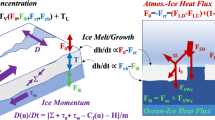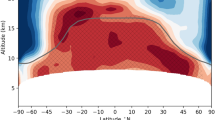Abstract
The behaviour of the Southern Hemisphere stratosphere has attracted considerable interest, and been compared with the Northern Hemisphere, since the International Geophysical Year (1957–58) when the sudden (“explosive” or “accelerated”) springtime warming phenomenon in the Antarctic was first observed. Over the years studies of upper air temperature and wind observations have been made, principally through the spring months when the polar vortex breakdown occurs, utilising both ground-based (rawinsonde, rocket) and more recently, satellite-derived data. Although the radiosonde-derived temperature data are limited both by the number of reporting stations, and the practical difficulty of securing observations much above the 100 hPa level, useful records exist from 1956 or 1957. These have shown that in the 1959 southern spring, the lower stratosphere was relatively colder, and the warming rate through the season was essentially more regular, with little evidence of the marked but short-lived temperature fluctuations usually found. Similar, but not quite such wide-spread conditions occurred again in the 1961 spring. In another study, 30 hPa temperature fields over the Antarctic continent, which could be drawn for the 1967 spring, showed the complexity of the polar vortex breakdown. These features are recalled because extension of the 100 hPa springtime temperature series for the Australian Antarctic station at Casey (66.3°S, 110.5°E) shows that in 1985 and part of 1986, the temperature behaviour there was similar to, but not quite so extreme as that which occurred at Mirny (66.5°S, 93.0°E) in 1959.
Similar content being viewed by others
References
Phillpot, H. R. (1964),The springtime accelerated warming phenomenon in the Antarctic stratosphere, International Antarctic Analysis Centre, Tech. Rep. No. 3, Commonwealth Bureau of Meteorology, Melbourne.
Phillpot, H. R. (1967a),Some further observations on Antarctic stratospheric warming, Polar Meteorology, W. M. O. Tech. Note87, 379–406.
Phillpot, H. R. (1967b),An examination of polar stratospheric warming using temperatures determined from TIROS VII radiation measurements, International Antarctic Meteorological Research Centre, Tech. Rep. No. 8, Commonwealth Bureau of Meteorology, Melbourne.
Phillpot, H. R. (1969),Antarctic stratospheric warming reviewed in the light of 1967 observations, Quart. J. R. Met. Soc.95, 329–348.
Phillpot, H. R. (1984),Satellite-derived radiance data over high southern latitudes, Met. Dept. Publ No. 26, University of Melbourne.
Wexler, H. (1959),Seasonal and other temperature changes in the Antarctic atmosphere, Quart. J. R. Met. Soc.85, 196–208.
Author information
Authors and Affiliations
Rights and permissions
About this article
Cite this article
Phillpot, H.R. A note on some early radiosonde temperature observations in the Antarctic lower stratosphere. PAGEOPH 130, 171–180 (1989). https://doi.org/10.1007/BF00874453
Received:
Revised:
Accepted:
Issue Date:
DOI: https://doi.org/10.1007/BF00874453




